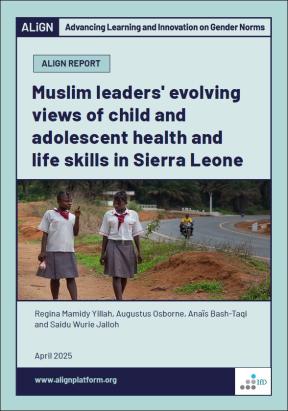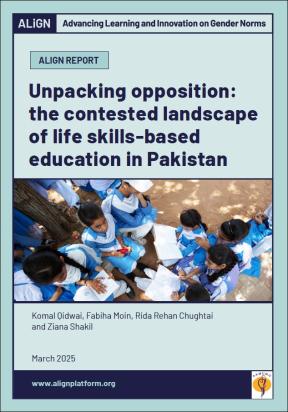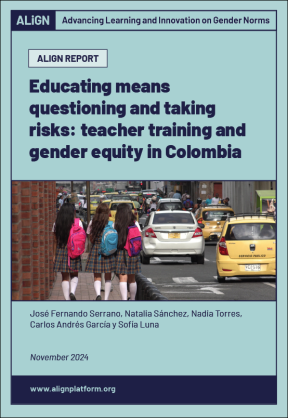- Case study
- 7 November 2018
Changing norms to tackle child marriage and promote sexual and reproductive health rights in India
- Published by: ALIGN
"My name is Pooja. I was 15 years old when my parents decided to try to marry me off as my father was unwell and couldn’t afford to pay for my education. It was also the year I enrolled in life skills education in my village and where I learnt the risks of early marriage.
I started working as a farm labourer and earned enough to pay for the cost of travel to the neighbouring village for higher education. I told my parents I would not get married until I had graduated from school.
I am now 18 years old, in class 12 at school and my parents have agreed to send me to college. My life changed after life skills education. Not a single girl in my village is married off now before she reaches 18 years."
Institute of Health Management, Pachod (IHMP), a non-profit organisation, is improving the lives of vulnerable adolescent girls in rural and urban slum communities in Maharashtra, India. It helps married adolescent girls by offering reproductive health services, which has led to fewer adolescent deaths caused by early pregnancy, and prevents low birthweight among babies by increasing the time interval between births. IHMP also provides life skills education to unmarried adolescent girls, empowering them to make independent life choices and negotiate with their families so that they can delay the age at which they marry.

IHMP’s work has also contributed to married adolescent girls delaying their first pregnancy, and a reduction in the health problems young girls face as a result of early motherhood.
Child marriage prevention programme
Key activities include the following:
Life skills education for unmarried adolescent girls (aged 11–19)
All the girls in a village are enrolled into this programme, and receive two sessions a week over six months. They are organised into kishori mandals (girls’ clubs) and the club elects its leaders and peer educators. Topics discussed include health (nutrition, personal hygiene, sexual and reproductive health (SRH)), as well as gender discrimination and how to deal with it. They also discuss laws and policies on issues affecting adolescent girls and women, and give girls practical skills in communication, decision-making and negotiation.
The programme also uses drama and street plays to get messages across, performed by the girls themselves, to audiences of parents, other villagers and community leaders. These plays help to promote new norms but also challenge existing norms about how girls are expected to behave in public places. They promote three main messages: (1) parents must not discriminate against girls; (2) educate girls and you educate an entire family; and (3) delaying age at marriage can reduce the enormous risks associated with early marriage and motherhood.
Behaviour change communication (BCC), engaging parents individually and in small groups
Community health workers (known as Accredited Social Health Activists, or ASHAs) are middle-aged women from the community that visit families once a month to assess their health needs, provide them with information and counselling related to their needs and link them to service providers. They talk to parents about the risks of early marriage and motherhood. Discussions usually focus on the risks of early marriage and conception, using examples of what has happened to girls in their own village who became mothers at a very young age. The ASHAs also talk about the advantages of keeping adolescent girls in education. Once a month, ASHAs gather parents in one place in the village and IHMP’s facilitator leads a group meeting. They talk about potential role models and individuals who have chosen a different course of action, asking them to share their perceptions and experiences with the rest of the group. This strategy has been particularly effective with mothers-in-law. The group meetings are key to the programme’s objective of influencing social norms and bringing about change.
This part of the programme provides life skills education and group counselling for boys and young men aged 15–24, alongside peer education. Impacts are measured by looking at changes in young men’s attitudes (married and unmarried men) towards women, using the Gender Equitable Men (GEM) scale, and by interviewing adolescent girls and young married women about the changes they have observed in boys’ and young men’s behaviour. The evaluation findings are not published as yet. The first time they were presented was at the Girls Not Brides global meeting.
Impacts
A 2006 survey of more than 1,650 girls found that life skills education contributed to a number of changes in delaying age at marriage:
- The proportion of girls getting married before 18 years fell from 80.7% to 61.8% after 18 months of attending life skills education.
- Girls who never attended life skills education were more than 2.5 times more likely to marry before the age of 18.
- The median age at marriage increased from 16 years to 17 years.
A second study looked at levels of self-esteem and self-efficacy among adolescent girls, and found some interesting changes:
- The proportion of adolescent girls with poor self-esteem fell from 9% to 2%.
- The proportion of girls with high self-esteem increased from 57% to 69%.
- The proportion of girls with low self-efficacy reduced from 14% to 3%.
- The proportion of girls with high self-efficacy increased from 48% to 60%.
The programme also appears to have contributed to change in gender norms among boys, as the proportion of male participants with high levels of gender-equitable attitudes increased after receiving the life skills education component, from 25.9% to 95.4% (as measured by the composite score for all 15 indicators of the GEM scale). The increase was equally dramatic among unmarried and married young men.
Sexual and reproductive health programme for married adolescent girls
- conducting monthly health needs assessments to identify their health and information needs
- preparing a monthly plan for each girl detailing her health care needs
- providing information and counselling that is specific to the needs of married adolescent girls and their families
- linking adolescent girls with government health providers and primary health care centres
- facilitating community-based monitoring by village health and sanitation committees (VHSCs) to ensure that the health needs of girls and young married women are addressed on a timely basis.
Impacts
The impacts of IHMP’s life skills education on the lives of three adolescent girls in Maharashtra
This is a story of three adolescent girls – Selvi, Rajshree and Smita – friends from Aurangabad district, Maharashtra. They have been able to exercise agency over the course of their own lives after attending IHMP’s life skills education course.
In 2013, Selvi’s aunt proposed that the then 14-year-old Selvi marry her much older son. Distressed by the proposal, Selvi went on a hunger strike, telling her parents that she wanted to study at least up to graduate level before getting married. Rajshree and Smita also visited Selvi’s parents, reminding them that it is illegal to marry a girl before the age of 18 years and of the risks associated with child marriage – knowledge they had acquired by participating in the life skills education course. They reminded Selvi’s parents of a street play they had performed four months earlier, in which a girl who married at age 16 conceived soon after, and died during childbirth. The girls asked Selvi’s parents why they would risk their daughter’s life.
In spite of the girls’ efforts, and feeling under pressure from the wider family, Selvi’s parents decided the next day to engage her to be married. While the engagement ceremony was being conducted, Rajshree and Smita mobilised the local ASHA (community health worker) and girls’ club (kishori mandal) members. The girls interrupted the ceremony, pleading with Selvi’s family to allow her to continue her studies, and stating that her family would be responsible for any ills that might befall Selvi as a result of being married at a young age. Collectively, they managed to persuade Selvi’s parents to call off the engagement at the last minute.
Selvi is now 18 years old, still unmarried, and is continuing her education. Both Selvi and Rajshree completed their life skills education course with IHMP and committed themselves to helping other girls to continue their education and avoid child marriage. They were chosen as peer educators by the girls in their village and now conduct training for other adolescent girls – an achievement their parents are proud of. Rajshree has written a play about the life of Savitribai Phule, a social activist who started the first school for girls in Maharashtra, which she performs in schools to empower girls to convince their parents to allow them to continue with their education and delay marriage.
All three girls are continuing with their education. Selvi and Rajshree want to complete teacher training, whereas Smita wants to become a doctor. In the meantime, Smita has also completed vocational training in sewing through IHMP, which, as well as paying for her education, enables her to contribute towards her family’s household expenses.
Lessons learned
The key to bringing about a change in gendered social norms is to involve girls and boys to create that change in their own communities. Change thus becomes integral to the community and results in a generational shift. However, changing gendered social norms like child or early marriage requires a sustained effort over a considerable period of time. The challenge lies in scaling this up through the existing structures and human resources established by government.
- Countries / Regions:
- India
Related resources
Report
14 April 2025

Report
26 March 2025

Report
13 November 2024
